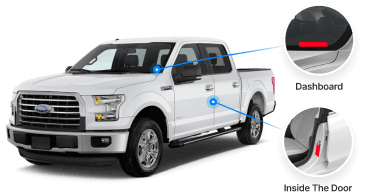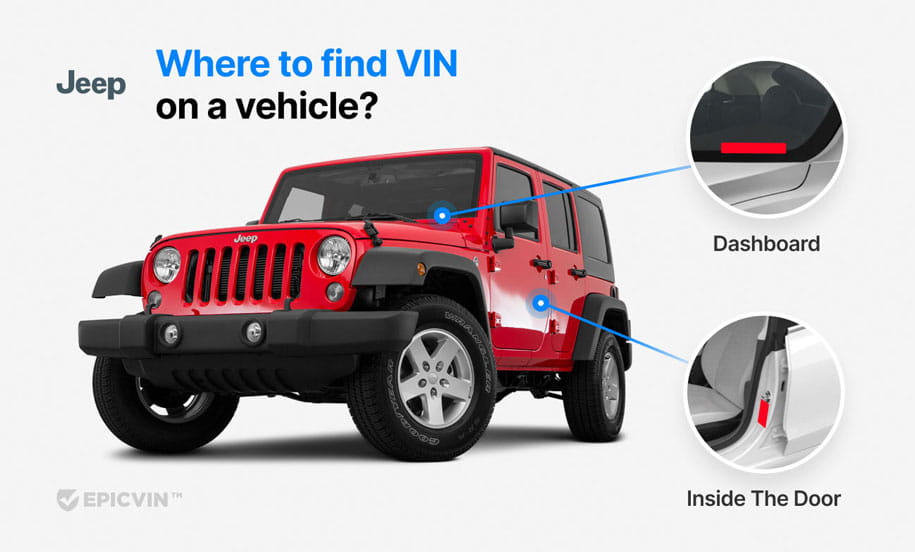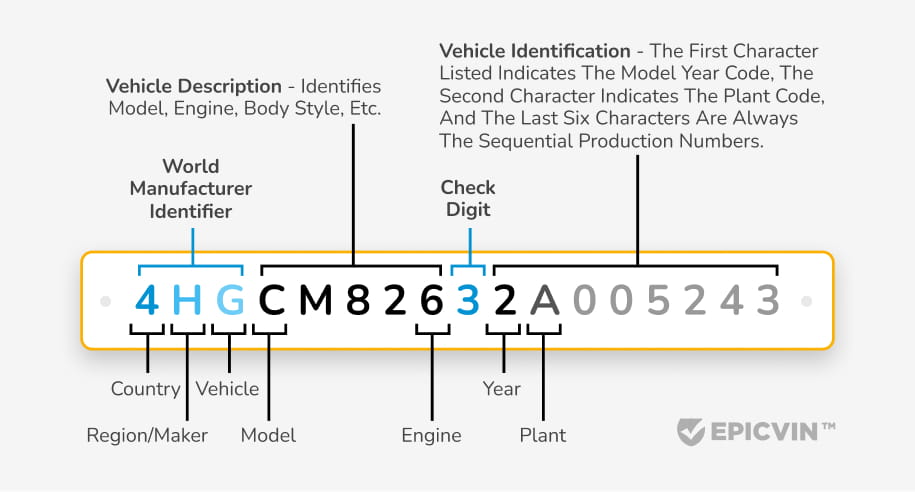
How to Sell a Car with a Loan
Discover the essential steps to successfully sell a car with an outstanding lo...
Read more
Check vehicle information with Jeep VIN
Looking for the VIN?
Here is there you’ll find it:

The original “GP” was a crash program to build a new vehicle for troops fighting WWII. After the war, the Jeep quickly found favor with people who needed a vehicle that could tackle difficult off-road driving. From there, the brand expanded with models that formed the basis of today’s SUV market. Today, Jeep makes SUVs and trucks for a wide range of buyers, from crossovers and luxury vehicles to serious off-road vehicles and drag strip-ready Trackhawk SUVs.
Whether you’re looking for your next off-roading project, or you want a daily driver that’s good both on and off-road, buying a Jeep is a major financial commitment. How can you be sure the vehicle you’re buying is authentic? By using our decoder, you can get a VIN check that tells you how a truck or SUV was equipped from the factory. This makes it easy to identify modifications and other tampering. You can take this a step further by ordering a VIN report, which pulls information from several sources to build a complete history on the vehicle. That way, you’ll know about accidents, title issues and other legal problems.
A VIN is issued to every vehicle when it’s built. This code is stamped and labeled in several places, so it can identify the vehicle through its life. However, it’s more than just a unique identifier. When you decode this set of digits, you can find out about when and where your Jeep was built, as well as its original equipment. This is especially handy on rare and special edition vehicles, where unscrupulous buyers may try to replicate features on a standard model to boost the price.
Jeep places the VIN in several locations on their vehicles, so they can always be identified. The Wrangler and its predecessors are designed with folding windshields and removable doors, so the manufacturer had to get creative with VIN placement. Here’s where you can find this code on your truck or SUV.
You can see the VIN from outside the vehicle by looking through the windshield. On some models, it’s printed on a small plate on the dashboard, next to the driver’s door and the windshield cowl. If you have a folding windshield, look at the edge of the glass. You should see the plate attached to the windshield frame.
Look at the B pillar, the door pillar behind the driver’s door. You will see a large silver sticker. The VIN is printed on this sticker above a bar code.
Open the hood. On older Jeeps, you should see a small metal plate on the firewall, near the brake master cylinder. The VIN is etched into this plate. Newer models have the VIN etched directly into the firewall, near the windshield wiper cowl.
Check the driver’s side foot well next to the parking brake lever. You can find the VIN number stamped on the inside of the fender.
Can you see the windshield wiper motor from inside the vehicle? If you can, the VIN is usually printed on the motor cover.
Check the right side frame rail. You will find a plastic or metal VIN plate next to the rear axle or below the front passenger door.

Your Jeep’s vehicle identification number is made up of several sections. Most of these characters describe the vehicle. Here’s some of the information you can learn when you use our decoder.

The first character is the country where the Jeep was built. The majority of vehicles sold in North America are built here. This character will be 1, 4 or 5 for vehicles built in the U.S. A 2 is used on Canadian-built Jeeps, while a 3 is used on vehicles built in Mexico.
The second character is the manufacturer. This is always “J” on North American market Jeeps. The third character is the region, which is usually “4” for Jeep’s North American operations.
The fourth character is the safety system installed at the factory:
| Code | EQUIPMENT |
|---|---|
| D | No airbags |
| A | Front and side airbags |
| H | Advanced front and side airbags |
| K | Advanced front airbags |
| L | Advanced front and side airbags |
The fifth character is the model and drive system:
| Code | DRIVE SYSTEM |
|---|---|
| 3, C, R | Grand Cherokee 4WD |
| S | Grand Cherokee 2WD |
| 6 | Cherokee 4WD |
| A | Wrangler 4WD |
| G | Commander 4WD |
| H | Commander 2WD |
| L | Liberty or Cherokee 4WD |
Character 6 is the trim level. 1 is the lowest level, while 5 is the highest. Sport models have an “S” for this character, while special editions use an “X”. This is standard labeling across Chrysler’s vehicles, and doesn’t always match up with the marketed trim level. For example, “5” may be used for two trims, while “4” isn’t used at all.
Character 7 is the body type:
| Code | BODY STYLE |
|---|---|
| 5 | Convertible |
| 8 | Hatchback or truck |
Character 8 is the engine. These are the codes for the engines currently used in Jeeps:
| Code | ENGINE |
|---|---|
| D, M | 3.0l turbo diesel |
| G | 3.5l high output V6 |
| H | 5.7l HEMI V8 |
| W | 6.1l HEMI V8 |
Character 9 is the check digit. It verifies that the VIN is authentic. This digit is created with a formula that uses other VIN characters in its calculations.
Character 10 is the model year, which alternates between numbers and letters. It doesn’t use “O”, “Z” or “I” to avoid confusion with numbers.
| Code | Country | Code | Country | Code | Country | Code | Country |
|---|---|---|---|---|---|---|---|
| E | 1984 | R | 1994 | 4 | 2004 | E | 2014 |
| F | 1985 | S | 1995 | 5 | 2005 | F | 2015 |
| G | 1986 | T | 1996 | 6 | 2006 | G | 2016 |
| H | 1987 | V | 1997 | 7 | 2007 | H | 2017 |
| J | 1988 | W | 1998 | 8 | 2008 | J | 2018 |
| K | 1989 | X | 1999 | 9 | 2009 | K | 2019 |
| L | 1990 | Y | 2000 | A | 2010 | L | 2020 |
| M | 1991 | 1 | 2001 | B | 2011 | M | 2021 |
| N | 1992 | 2 | 2002 | C | 2012 | N | 2022 |
| P | 1993 | 3 | 2003 | D | 2013 | P | 2023 |
The 11th digit is the assembly plant. Most Jeeps sold here are made in these three locations:
| Code | PLANT |
|---|---|
| L, P or T | Toledo, Ohio |
| D | Belvidere, Illinois |
| J | Brampton, Ontario |
The 12th through 17th digits are the serial number. Serial numbers are reused, but the full VIN number is unique to each vehicle.
What kind of information can you get when you use our VIN decoder? Here are a few examples:
When you order a full VIN report, you’ll also get information on previous titles, accident reports and more. That way, you know the history of the vehicle, helping you uncover mechanical and legal problems that might be hidden by the seller.












Locations vary from manufacturer to manufacturer. However, there are three places you can find the code on most vehicles:
- Look through the windshield at the dashboard. On the driver’s side, you should see a small metal plate with the number stamped into it.
- Open the driver’s door. Look at the front and side of the door pillar for an I.D. sticker. It usually has the manufacturer’s logo on it. The code should be on this sticker.
- Open the hood. You may see a sticker on the firewall or near the passenger’s side strut tower. Some cars have the number engraved in one of these areas.
Since this number is used to identify the vehicle on official documents, you can also find it on the title, the window sticker, and on insurance policies.
We also decode numbers for RVs, heavy-duty trucks and motorcycles. If you need to decode an RV number, make sure it’s the one issued by the chassis manufacturer, not the RV outfitter.
No. Canadian and Mexican cars usually use the same format. Other countries use their own formats.
It’s up to the manufacturer to determine what they want to include for some parts of the number. For example, some companies don’t include information about transmissions or trim levels.
Usually, no. A few manufacturers stamp the code into the engine. If the VINs on the engine and car match, then it’s the original engine. On most vehicles, there isn’t anything that ties an engine to a specific vehicle. At most, looking up the vehicle on our website will tell you if a different type of engine was installed. For example, if someone swaps a V8 into a Ford Mustang, our site will tell you it originally came with a V6.
Discover expert tips, news and advice on buying and maintaining used vehicles

Discover the essential steps to successfully sell a car with an outstanding lo...
Read more
A detailed explanation of certified used cars and if it is wise to look into t...
Read more
Check out these useful tips that will help you extend the life of the vehicle.
Read more